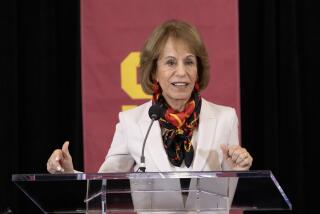USC Program Eases Faculty Home Buying : Housing: The university offers a $25,000 subsidy to each eligible employee who purchases in target areas near its campuses.
- Share via
With his salary as coordinator for minority outreach programs at USC’s medical school, Carlos Venegas can’t afford both a home mortgage and the other costs of supporting his family.
So the single father of two rents a three-bedroom house in Covina and each day braves the 1-hour, bumper-to-bumper commute to the Boyle Heights campus.
But a new university program aimed at encouraging homeownership among staff and faculty members may change that.
Last month, USC launched its Neighborhood Homeownership Program, which offers each eligible participant a $25,000 subsidy from the school’s general fund to settle in the areas around the medical school and the university’s main campus at the edge of Exposition Park.
“With the financial support they provide you, it’s a great opportunity to buy property,” said Venegas, who has already begun looking for a house close to his job. “Without the program, I probably wouldn’t be able to do it.”
*
The program, school officials said, is also designed to revitalize economically sluggish areas and further the private university’s efforts to improve relations with surrounding neighborhoods, which have criticized the university for not reaching out to its mostly working-class neighbors. Some still resent the institution for installing a brick and wrought-iron fence around the main campus in 1984.
Patterned after a similar program at Yale University in New Haven, Conn., the USC plan issues monthly payments to new homeowners over seven years. But unlike Yale’s, the USC program gradually decreases the subsidy to wean participants off the assistance.
Eligible employees must work for the university at least 20 hours a week and must have purchased and occupied homes in a designated radius around the two campuses after Jan. 1.
The target area for the main campus is bounded by the Santa Monica and Harbor freeways, Normandie Avenue and Martin Luther King Jr. Boulevard. The medical school area boundaries are the Golden State Freeway, Broadway, Brooklyn Avenue and Indiana Street. Initial payments are issued only after employees prove they have acquired and moved into a home. The payments would end if the employee leaves the university.
Administrative Services Coordinator Heidi Todeschi has already had to order 500 new application packets to replace the 175 she stacked at various campus locations late last month. “They’re going like hot cakes,” she said.
Besides applications, the packets include information on financing opportunities and first-time homeowner classes.
*
No applications have been returned to the school’s treasurer, but administrators expected a lag time between the program’s kickoff and the first requests for subsidies.
The amount was chosen based on the average yearly incomes of staff and faculty members and estimated median property value ($150,000) in the target areas, said Pat Oliver, an administrator who helped devised the program.
The university had been looking at other ways to spur homeownership among employees but determined the program selected was the best way, Oliver said, “to make the most change in the shortest period of time.”
Reaction among university neighbors, however, has been mixed.
For Jim Childs, who owns a home four blocks from the main campus, the program is “terrific.”
“I think it’s going to be very beneficial,” said Childs, a free-lance film animator who has lived in the area for 16 years.
Childs predicts the program will help jump-start the slumping local economy as new services spring up to cater to the new homeowners. “The vacant stores all boarded up will now be open,” he said.
But a few blocks away, Richard Woods, who has lived in the area for 69 years, worries the new businesses generated by the program may cater only to professionals and academicians and ignore the needs and pocketbooks of the area’s majority working-class residents.
“If they want to come in and live, that’s fine,” said Woods, a retired laborer. “If they want to come in and gentrify, I don’t think it’s fine.”
Still, Woods said he’d welcome more homeowners to the vicinity because they tend to take better care of their property and help improve the area as a whole.
“It would be good to have people who are truly interested in the neighborhood.”
More to Read
Sign up for Essential California
The most important California stories and recommendations in your inbox every morning.
You may occasionally receive promotional content from the Los Angeles Times.






